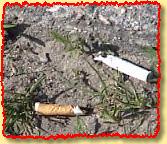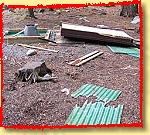
Frontcountry Guidelines

I think the environment should be put in the category of our national security. |
 When "Leave No Trace" is discussed, the wilderness backcountry is usually the environment that comes to mind. Research shows that the majority of outdoor use occurs as weekend or day trips in frontcountry areas close to population centers. Urban parks, public recreation areas, and established campgrounds receive the brunt of human impact day after day. These environments are not pristine and far from wild, but the Leave No Trace guidelines are still relevant in these manicured locations.
When "Leave No Trace" is discussed, the wilderness backcountry is usually the environment that comes to mind. Research shows that the majority of outdoor use occurs as weekend or day trips in frontcountry areas close to population centers. Urban parks, public recreation areas, and established campgrounds receive the brunt of human impact day after day. These environments are not pristine and far from wild, but the Leave No Trace guidelines are still relevant in these manicured locations.
Frontcountry is composed of outdoor areas that are easily accessible by vehicle and mostly visited by day users. Developed campgrounds are also included in the frontcountry arena. Frontcountry locations tend to be more crowded and attract a wider range of visitor than backcountry. This in turn creates quite a list of common frontcountry concerns:
- Conflicts between visitors
- Litter, grafitti, and vandalism
- Off-trail hiking and cutting switchbacks
- Pet management and waste
- Removal of plants, artifacts, and natural objects
- Safety of visitors
- Trespassing on adjacent properties
- Wildlife habituation and harrassment
 When you take a walk through any city park or neighborhood, you'll see cigarette butts, bits of paper, a pile or two of dog poop, and maybe even spray paint on a wall. You'll see the same thing at a frontcountry campground, plus initials carved into picnic tables and trees, cans in fire grates, and broken toilets. It isn't just where you live - from Oregon to New Jersey we see the same problem with people abusing and neglecting their public resources. Rules are already in place to prevent it, but it continues to happen. So, how can the problem be solved?
When you take a walk through any city park or neighborhood, you'll see cigarette butts, bits of paper, a pile or two of dog poop, and maybe even spray paint on a wall. You'll see the same thing at a frontcountry campground, plus initials carved into picnic tables and trees, cans in fire grates, and broken toilets. It isn't just where you live - from Oregon to New Jersey we see the same problem with people abusing and neglecting their public resources. Rules are already in place to prevent it, but it continues to happen. So, how can the problem be solved?
The Leave No Trace message is a great step in the right direction. Americans have been taught that they deserve a good life and they have the right to treat 'public' places however they want. By teaching a new message of conservation and ethical choices, much of the problem will stop. Some of the problem is malicious activity and will not easily be stopped, but much of the damage is caused by thoughtlessness which is easy to prevent.
Signs and brochures explaining the Leave No Trace principles available at campground check-ins, trailheads, and urban parks have already demonstrated significant reduction in damage. The Boy Scouts of America have created Leave No Trace awards for Cub Scouts and Boy Scouts, ensuring the message begins with younger boys and continues to be heard as they get older. Some elementary schools have Leave No Trace incorporated into their classes and there is a recreational ecology offering in some college curriculum.
 Frontcountry recreation is enjoyed by more people of differing experience levels, goals, and backgrounds than backcountry recreation. Anyone you meet backpacking in the wilderness will have a set of basic hiking, packing, and camping skills but people in a state park range from a family on their first camping trip to a group of college guys having a beer party. These varying groups bring varying levels of knowledge of proper use and respect for the resource. Conflict between people wanting to 'have fun' and others wanting to 'get away from it all' occurs in highly used areas.
Frontcountry recreation is enjoyed by more people of differing experience levels, goals, and backgrounds than backcountry recreation. Anyone you meet backpacking in the wilderness will have a set of basic hiking, packing, and camping skills but people in a state park range from a family on their first camping trip to a group of college guys having a beer party. These varying groups bring varying levels of knowledge of proper use and respect for the resource. Conflict between people wanting to 'have fun' and others wanting to 'get away from it all' occurs in highly used areas.
The potential for abuse and misuse of frontcountry resources is much greater than backcountry, but the impact from each poor choice in the backcountry is greater. Since frontcountry resources are already highly impacted, a few poor choices are less noticable and easier to take care of. In more pristine backcountry environments, a few poor choices will leave long-lasting scars that might not be noticed in an already impacted frontcountry setting.

